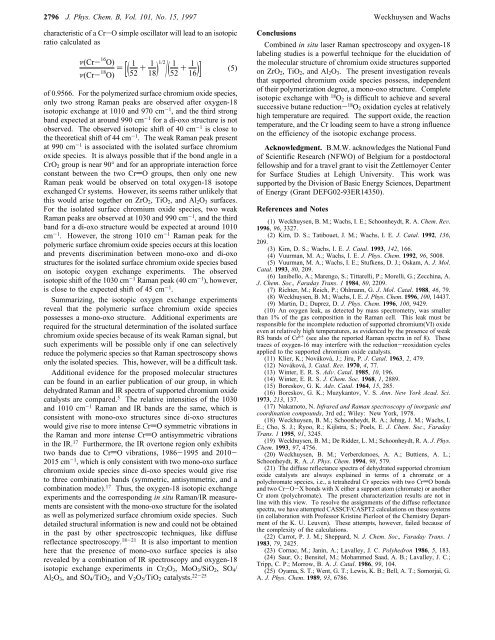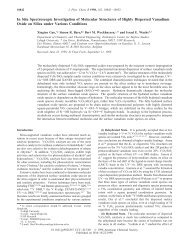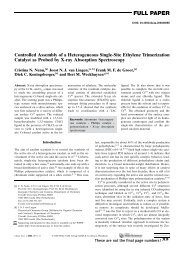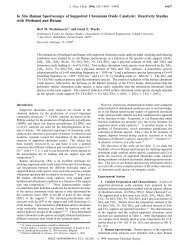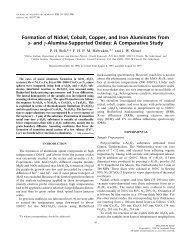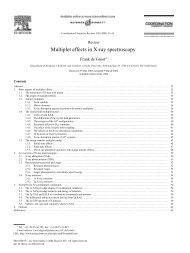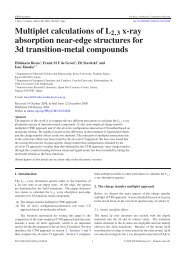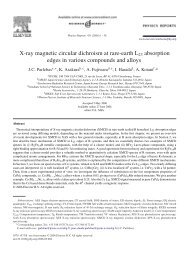View - Inorganic Chemistry and Catalysis
View - Inorganic Chemistry and Catalysis
View - Inorganic Chemistry and Catalysis
You also want an ePaper? Increase the reach of your titles
YUMPU automatically turns print PDFs into web optimized ePapers that Google loves.
2796 J. Phys. Chem. B, Vol. 101, No. 15, 1997 Weckhuysen <strong>and</strong> Wachs<br />
characteristic of a Cr-O simple oscillator will lead to an isotopic<br />
ratio calculated as<br />
ν(Cr- 16 O)<br />
ν(Cr- 18 O) ) [( 1<br />
52 + 1<br />
18) 1/2<br />
/( 1<br />
52 + 1<br />
16)] (5)<br />
of 0.9566. For the polymerized surface chromium oxide species,<br />
only two strong Raman peaks are observed after oxygen-18<br />
isotopic exchange at 1010 <strong>and</strong> 970 cm -1 , <strong>and</strong> the third strong<br />
b<strong>and</strong> expected at around 990 cm -1 for a di-oxo structure is not<br />
observed. The observed isotopic shift of 40 cm -1 is close to<br />
the theoretical shift of 44 cm -1 . The weak Raman peak present<br />
at 990 cm -1 is associated with the isolated surface chromium<br />
oxide species. It is always possible that if the bond angle in a<br />
CrO 2 group is near 90° <strong>and</strong> for an appropriate interaction force<br />
constant between the two CrdO groups, then only one new<br />
Raman peak would be observed on total oxygen-18 isotope<br />
exchanged Cr systems. However, its seems rather unlikely that<br />
this would arise together on ZrO 2 , TiO 2 , <strong>and</strong> Al 2 O 3 surfaces.<br />
For the isolated surface chromium oxide species, two weak<br />
Raman peaks are observed at 1030 <strong>and</strong> 990 cm -1 , <strong>and</strong> the third<br />
b<strong>and</strong> for a di-oxo structure would be expected at around 1010<br />
cm -1 . However, the strong 1010 cm -1 Raman peak for the<br />
polymeric surface chromium oxide species occurs at this location<br />
<strong>and</strong> prevents discrimination between mono-oxo <strong>and</strong> di-oxo<br />
structures for the isolated surface chromium oxide species based<br />
on isotopic oxygen exchange experiments. The observed<br />
isotopic shift of the 1030 cm -1 Raman peak (40 cm -1 ), however,<br />
is close to the expected shift of 45 cm -1 .<br />
Summarizing, the isotopic oxygen exchange experiments<br />
reveal that the polymeric surface chromium oxide species<br />
possesses a mono-oxo structure. Additional experiments are<br />
required for the structural determination of the isolated surface<br />
chromium oxide species because of its weak Raman signal, but<br />
such experiments will be possible only if one can selectively<br />
reduce the polymeric species so that Raman spectroscopy shows<br />
only the isolated species. This, however, will be a difficult task.<br />
Additional evidence for the proposed molecular structures<br />
can be found in an earlier publication of our group, in which<br />
dehydrated Raman <strong>and</strong> IR spectra of supported chromium oxide<br />
catalysts are compared. 5 The relative intensities of the 1030<br />
<strong>and</strong> 1010 cm -1 Raman <strong>and</strong> IR b<strong>and</strong>s are the same, which is<br />
consistent with mono-oxo structures since di-oxo structures<br />
would give rise to more intense CrdO symmetric vibrations in<br />
the Raman <strong>and</strong> more intense CrdO antisymmetric vibrations<br />
in the IR. 17 Furthermore, the IR overtone region only exhibits<br />
two b<strong>and</strong>s due to CrdO vibrations, 1986-1995 <strong>and</strong> 2010-<br />
2015 cm -1 , which is only consistent with two mono-oxo surface<br />
chromium oxide species since di-oxo species would give rise<br />
to three combination b<strong>and</strong>s (symmetric, antisymmetric, <strong>and</strong> a<br />
combination mode). 17 Thus, the oxygen-18 isotopic exchange<br />
experiments <strong>and</strong> the corresponding in situ Raman/IR measurements<br />
are consistent with the mono-oxo structure for the isolated<br />
as well as polymerized surface chromium oxide species. Such<br />
detailed structural information is new <strong>and</strong> could not be obtained<br />
in the past by other spectroscopic techniques, like diffuse<br />
reflectance spectroscopy. 18-21 It is also important to mention<br />
here that the presence of mono-oxo surface species is also<br />
revealed by a combination of IR spectroscopy <strong>and</strong> oxygen-18<br />
isotopic exchange experiments in Cr 2 O 3 , MoO 3 /SiO 2 , SO 4 /<br />
Al 2 O 3 , <strong>and</strong> SO 4 /TiO 2 , <strong>and</strong> V 2 O 5 /TiO 2 catalysts. 22-25<br />
Conclusions<br />
Combined in situ laser Raman spectroscopy <strong>and</strong> oxygen-18<br />
labeling studies is a powerful technique for the elucidation of<br />
the molecular structure of chromium oxide structures supported<br />
on ZrO 2 , TiO 2 , <strong>and</strong> Al 2 O 3 . The present investigation reveals<br />
that supported chromium oxide species possess, independent<br />
of their polymerization degree, a mono-oxo structure. Complete<br />
isotopic exchange with 18 O 2 is difficult to achieve <strong>and</strong> several<br />
successive butane reduction- 18 O 2 oxidation cycles at relatively<br />
high temperature are required. The support oxide, the reaction<br />
temperature, <strong>and</strong> the Cr loading seem to have a strong influence<br />
on the efficiency of the isotopic exchange process.<br />
Acknowledgment. B.M.W. acknowledges the National Fund<br />
of Scientific Research (NFWO) of Belgium for a postdoctoral<br />
fellowship <strong>and</strong> for a travel grant to visit the Zettlemoyer Center<br />
for Surface Studies at Lehigh University. This work was<br />
supported by the Division of Basic Energy Sciences, Department<br />
of Energy (Grant DEFG02-93ER14350).<br />
References <strong>and</strong> Notes<br />
(1) Weckhuysen, B. M.; Wachs, I. E.; Schoonheydt, R. A. Chem. ReV.<br />
1996, 96, 3327.<br />
(2) Kim, D. S.; Tatibouet, J. M.; Wachs, I. E. J. Catal. 1992, 136,<br />
209.<br />
(3) Kim, D. S.; Wachs, I. E. J. Catal. 1993, 142, 166.<br />
(4) Vuurman, M. A.; Wachs, I. E. J. Phys. Chem. 1992, 96, 5008.<br />
(5) Vuurman, M. A.; Wachs, I. E.; Stufkens, D. J.; Oskam, A. J. Mol.<br />
Catal. 1993, 80, 209.<br />
(6) Ianibello, A.; Marengo, S.; Tittarelli, P.; Morelli, G.; Zecchina, A.<br />
J. Chem. Soc., Faraday Trans. 1 1984, 80, 2209.<br />
(7) Richter, M.; Reich, P.; Ohlmann, G. J. Mol. Catal. 1988, 46, 79.<br />
(8) Weckhuysen, B. M.; Wachs, I. E. J. Phys. Chem. 1996, 100, 14437.<br />
(9) Martin, D.; Duprez, D. J. Phys. Chem. 1996, 100, 9429.<br />
(10) An oxygen leak, as detected by mass spectrometry, was smaller<br />
than 1% of the gas composition in the Raman cell. This leak must be<br />
responsible for the incomplete reduction of supported chromium(VI) oxide<br />
even at relatively high temperatures, as evidenced by the presence of weak<br />
RS b<strong>and</strong>s of Cr 6+ (see also the reported Raman spectra in ref 8). These<br />
traces of oxygen-16 may interfere with the reduction-reoxidation cycles<br />
applied to the supported chromium oxide catalysts.<br />
(11) Klier, K.; Nováková, J.; Jiru, P. J. Catal. 1963, 2, 479.<br />
(12) Nováková, J. Catal. ReV. 1970, 4, 77.<br />
(13) Winter, E. R. S. AdV. Catal. 1985, 10, 196.<br />
(14) Winter, E. R. S. J. Chem. Soc. 1968, 1, 2889.<br />
(15) Boreskov, G. K. AdV. Catal. 1964, 15, 285.<br />
(16) Boreskov, G. K.; Muzykantov, V. S. Ann. New York Acad. Sci.<br />
1973, 213, 137.<br />
(17) Nakamoto, N. Infrared <strong>and</strong> Raman spectroscopy of inorganic <strong>and</strong><br />
coordination compounds, 3rd ed.; Wiley: New York, 1978.<br />
(18) Weckhuysen, B. M.; Schoonheydt, R. A.; Jehng, J. M.; Wachs, I.<br />
E.; Cho, S. J.; Ryoo, R.; Kijlstra, S.; Poels, E. J. Chem. Soc., Faraday<br />
Trans. 1 1995, 91, 3245.<br />
(19) Weckhuysen, B. M.; De Ridder, L. M.; Schoonheydt, R. A. J. Phys.<br />
Chem. 1993, 97, 4756.<br />
(20) Weckhuysen, B. M.; Verberckmoes, A. A.; Buttiens, A. L.;<br />
Schoonheydt, R. A. J. Phys. Chem. 1994, 98, 579.<br />
(21) The diffuse reflectance spectra of dehydrated supported chromium<br />
oxide catalysts are always explained in terms of a chromate or a<br />
polychromate species, i.e., a tetrahedral Cr species with two CrdO bonds<br />
<strong>and</strong> two Cr-O-X bonds with X either a support atom (chromate) or another<br />
Cr atom (polychromate). The present characterization results are not in<br />
line with this view. To resolve the assignments of the diffuse reflectance<br />
spectra, we have attempted CASSCF/CASPT2 calculations on these systems<br />
(in collaboration with Professor Kristine Pierloot of the <strong>Chemistry</strong> Department<br />
of the K. U. Leuven). These attempts, however, failed because of<br />
the complexity of the calculations.<br />
(22) Carrot, P. J. M.; Sheppard, N. J. Chem. Soc., Faraday Trans. 1<br />
1983, 79, 2425.<br />
(23) Cornac, M.; Janin, A.; Lavalley, J. C. Polyhedron 1986, 5, 183.<br />
(24) Saur, O.; Bensitel, M.; Mohammed Saad, A. B.; Lavalley, J. C.;<br />
Tripp, C. P.; Morrow, B. A. J. Catal. 1986, 99, 104.<br />
(25) Oyama, S. T.; Went, G. T.; Lewis, K. B.; Bell, A. T.; Somorjai, G.<br />
A. J. Phys. Chem. 1989, 93, 6786.


